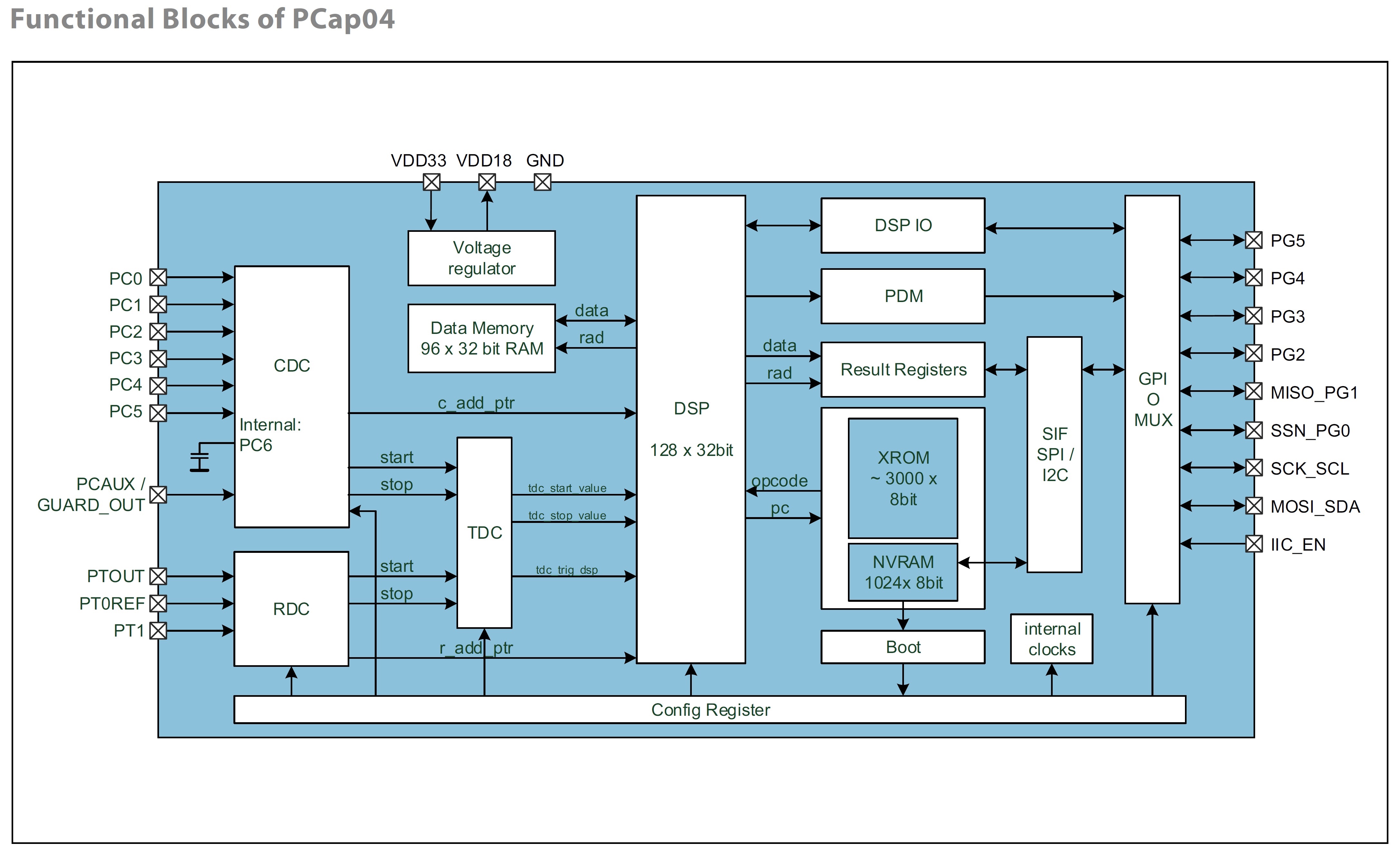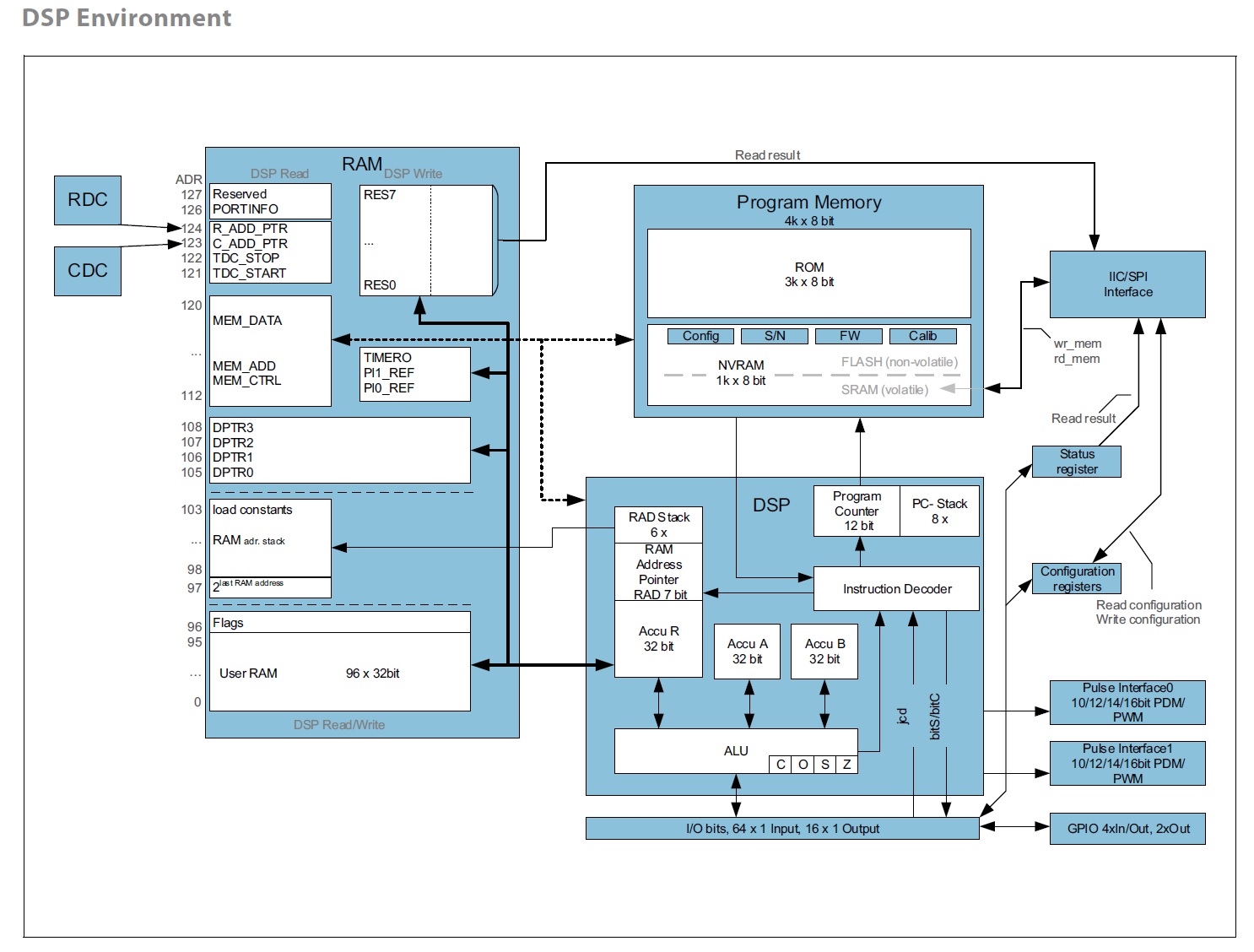A Powerful Yet Flexible Capacitance-to-Digital Converter from ams
A new CDC capable of measuring capacitance changes ranging from a few picofarads to hundreds of nanofarads.
A new CDC capable of measuring capacitance changes ranging from a few picofarads to hundreds of nanofarads.
ams recently announced their new PCap04, which is a configurable capacitance-to-digital converter (CDC) with an integrated (on-chip) digital signal processor (DSP) for post-processing operations (see the image below for the IC's functional blocks).
Two examples of such post-processing functions are the linearization of data and creating temperature-compensated information by means of the RDC (resistance-to-digital converter) port; the RDC port is intended for taking temperature sensor measurements.

Figure 1. Functional blocks of the PCap04. Diagram taken from the datasheet (PDF).
The 32-bit DSP works by reading, from the RAM, the CDC and RDC raw data, processing this data, and then writing the now-processed data back to the RAM. Although the DSP is internally clocked at 60MHz, its clock can be stopped using a firmware command for the purpose of saving power. And speaking of power savings, the PCap04 can be configured by the designer to allow for an appropriate balance between power consumption, data resolution, and data sample rate (speed). The image below depicts the DSP environment.

Figure 2. PCap04 DSP environment. Diagram taken from the datasheet (PDF).
Available in Two Packages... One of Which Is Tiny
This powerful CDC is available in two packages. One is a 24-pin QFN (quad flat no-leads) that measures only 4mm × 4mm × 0.9mm (see image below).

Figure 3. QFN package dimensions, from the datasheet (PDF).
And although the QFN package is quite small, it's rather large compared to the other package type, which isn't actually a "package" at all but simply the die itself, which measures only 1.59mm × 1.46mm × 290µm! When using the die option, be sure—as I often recommend when using such tiny packages—that your manufacturing facilities (the board house and the assembly plant) and your PCB layout team are capable of working with such tiny parts.

Figure 4. Die dimensions, from the datasheet (PDF).
Flexibility Allows for High Resolution or High Speed
This IC is touted, by ams, as being a highly flexible CDC that is capable of either gathering high-resolution data or having a high sample rate. When configured for high resolution, the IC can detect changes as low as 8aF (with a 10pF base capacitance) at a sample rate of 2.5Hz. Keep in mind that an aF (or attofarad) is 10−18 farads; this level of sensitivity is seriously impressive. In the interest of full disclosure, I've never designed a capacitance-sensing device. However, 8aF seems like an incredibly minute amount of capacitance, which makes me wonder what application(s) would realistically require such a high resolution. If you have experience with capacitance-sensing devices and can provide a real-life application that calls for 8aF of capacitance resolution, please share your experience with us.
For applications that need high sampling rates, the PCap04 can perform up to 50,000 samples per second. And while this spec also seems impressive, I again am wondering what sort of CDC application requires such a high sample rate.
Some Application Hints, and an Evaluation Kit
To help engineers with their designs, ams provides application guidelines, such as suggesting that shielded cables should be used for long wires and that the wire’s shielding should be grounded at the PCB (see image below).

Figure 5. Using and grounding shielded cables, from the datasheet (PDF).
For operation, the PCap04 requires only a few external components, and ams has provided the following schematic recommendations (see image below).

Figure 6. External component recommendations. Diagram taken from the datasheet (PDF).
Another application hint is that when using the die package, bonding to the die can be minimized for applications that require only a single sensor (see image below).

Figure 7. Bonding the die on only two sides. Diagram taken from the datasheet (PDF).
Finally, as noted in their PCap04 press release, ams provides an evaluation kit (EVAL-PCAP04) for assisting design engineers with the development, testing, and debugging of their code (see image below). It appears, however, that this eval kit is only available from ams via their Request Price link. It's a bummer that the kit can't simply be purchased through a distributor such as Digi-Key or Mouser.

Figure 8. The PCap04 evaluation kit. Image courtesy of ams.com.
Have you had a chance to use this new PCap04 capacitance-to-digital converter from ams? If so, leave a comment and tell us about your experiences.








I bought my eval kit from Digikey a couple month ago. However it was for the PCap02 board I ordered. https://www.digikey.fi/product-detail/en/ams/PCAP02-EVA-KIT/PCAP02-EVA-KIT-ND/5405918
If you need PCap04 you have to order this kit and add the PCap04 eval board: https://www.digikey.fi/product-detail/en/ams/PCAP04-EVA-BOARD/PCAP04-EVA-BOARD-ND/8346015
All PCap Eval board uses the same programmer and mother board.